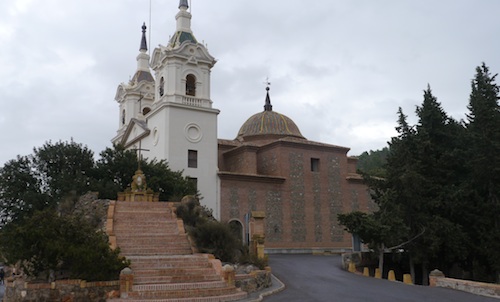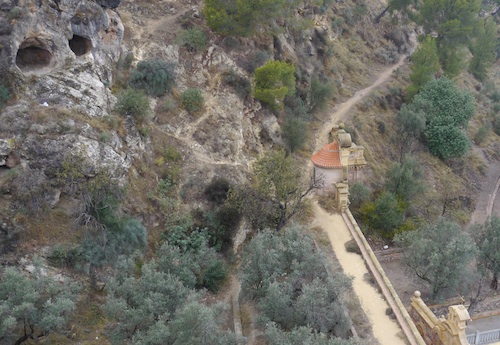By Professor Carol on Dec 12, 2015 04:00 am
Depending on your heritage, the experience of Christian pilgrimage may, or may not, be part of your life. Today we hear talk of “pilgrimages” to all kinds of places, including historical battlefields and football games. But pilgrimage is more significant than anything we can concoct in our modern world.

Santuario de la Fuensanta – © 2013 MF Reynolds
I devoted a lot of attention to pilgrimages in our Early Sacred Music course. Pilgrimages explain so much of Medieval history. The monasteries and shrines along European routes to Santiago de Compostela testify to the popularity and seriousness of these journeys. The famous 12th-century manuscript Codex Calixtinuscontains not only music and sermons for pilgrims but doubles as a kind of Michelin Guide—where to stop along the way and what to eat.
I recently visited the Santuario de la Fuensanta, high above the city of Murcia, Spain. Our local guide proudly pointed down at a steep path dotted with shrines commemorating the events in Christ’s crucifixion (Stations of the Cross). “Today, this is completely quiet, don’t you see? No one is here. Only those stray cats.” He grew more animated. “But when the pilgrimage begins, there will be hundreds of thousands of people on this path. Hundreds of thousands, do you see? Can you imagine it? It will not be the same here, no not at all.”

Pilgrimage Path in Murcia, Spain – © 2013 MF Reynolds
Today, December 12, marks a great pilgrimage in the Christian history of the Americas. Starting before midnight on December 11th, songs and prayers are raised by hundreds of thousands of Christians who have journeyed to Mexico City to honor The Virgin of Guadalupe.
The Virgin of Guadalupe is far more than a religious icon. Since the 16th century, her image has served as the most powerful unifying symbol in Mexican culture. The author Carlos Fuentes is quoted as saying “you cannot truly be considered a Mexican unless you believe in The Virgin of Guadalupe.”
The story has been told endlessly. On December 9, 1531, the image of a young girl appeared to a peasant named Juan Diego on Tepeyac Hill. She asked him to seek permission to build a cathedral on that spot. Troubled, Diego went to the Spanish bishop, asking advice. The bishop challenged him to return and gather proof. The Virgin of Guadalupe appeared again, and told Diego to seek and gather Castilian roses. (I love how often roses fit into miraculous stories, with my favorite being St. Elizabeth of Thuringia.)
Diego obeyed, and found the roses, not only out of season, but of a kind that ordinarily did not grow there. Gathering the roses in his cloak (tilma), he took them on December 12th to the bishop. When Diego opened the cloak, the roses fell to the floor, leaving a stunning imprint of the Virgin Mary.
Since her Feast Day falls in the preparatory season of Advent, her messages draw our attention in a special way. Revered now as the Protectoress of Unborn Children, The Virgin of Guadalupe inspires us to remember Joseph and Mary, anxiously winding their way to Bethlehem as the birth of Jesus drew near. Her command to a peasant to seek roses in mid-December reminds us to respond with obedience to calls of faith that seem illogical in our modern era.
She also reminds us that God finds us where we dwell: she spoke to one who seemed to have no importance, and she did it in his native dialect. Diego took more than flowers to bishop. He took absolute faith.
Built on the spot of Diego’s vision, the Cathedral of Our Lady of Guadalupe is the most famous Latin America pilgrimage site. Along with other great pilgrimage destinations—Jerusalem, Rome, Santiago de Compostela, Canterbury, and many others—it calls us to remember acts of faith and God’s presence in the world.
During the season of Advent, let’s teach our children that “pilgrimage” is not a trendy word, but an intense desire to draw closer to Christ. We are all called to pilgrimage, whether on our knees up a rocky path or through daily prayer and obedience. As we do, we take another step along the path to the birth of Christ.
Read in browser »
 
Recent Articles:
|
No comments:
Post a Comment